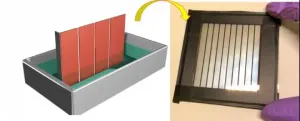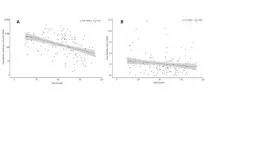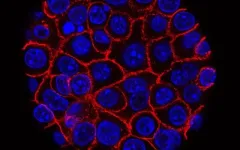How bushfire smoke traveled around the world
A study uncovers how some Australian fires produced a spreading stratospheric haze rivaling that of a volcanic eruption
2021-03-18
(Press-News.org) It's not just how hot the fires burn - it's also where they burn that matters. During the recent extreme fire season in Australia, which began in 2019 and burned into 2020, millions of tons of smoke particles were released into the atmosphere. Most of those particles followed a typical pattern, settling to the ground after a day or week; yet the ones created in fires burning in one corner of the country managed to blanket the entire Southern hemisphere for months. A pair of Israeli scientists managed to track puzzling January and February 2020 spikes in a measure of particle-laden haze to those fires, and then, in a paper recently published in Science, they uncovered the "perfect storm" of circumstances that swept the particles emitted from those fires into the upper atmosphere and spread them over the entire Southern Hemisphere.
Particles reaching the stratosphere - the upper layer of the atmosphere - most often get there through volcanic eruptions. The ash emitted in the more extreme eruptions dims the sun and cools the planet, as well as producing spectacular sunsets. Prof. Ilan Koren of the Weizmann Institute of Science's Earth and Planetary Science Department, who conducted the study together with his former student, Dr. Eitan Hirsch, now the Head of the Environmental Sciences Division at the Israel Institute for Biological Research in Ness Tziona, had noticed an extreme increase in a satellite-based measure of particle loading in the atmosphere called AOD - or aerosol optical depth. In January 2020, those measurements, plotted in standard deviations, showed a deviation three times the normal - some of the highest readings ever obtained, higher even than those from Mt. Pinatubo in 1991. But the timing did not coincide with any volcanic activity. They wondered if fires might be to blame, even though it is rare for the smoke from fires to escape the lower layer of atmosphere known as the troposphere in significant amounts. The troposphere extends from the ground to a height of several kilometers, and if smoke particles manage to rise that high, they hit an inversion layer called the tropopause that acts as a sort of ceiling between the troposphere and the stratosphere.
Working backwards and using data from several satellites, including, in addition to AOD, LIDAR readings that revealed how the particles were distributed vertically in "slices" of atmosphere, the two were able to prove that the source of the spikes was bushfires - specifically those burning in Southeastern Australia. Further analysis of satellite data revealed the broad band of haze in the stratosphere spreading to cover the Southern hemisphere, peaking from January to March and persisting through July; reaching all the way around and back to Australia's west coast.
How did these smoke particles penetrate through the tropopause ceiling and why did they come from these fires and not the others? One clue, says Hirsch, lay in another, distant forest fire that had occurred several years ago in Canada. Then, too, high AOD levels had been recorded. Both of these fires occurred in high latitudes, away from the equator.
The height of the troposphere shrinks at these latitudes: Over the tropics its upper ceiling can reach up to 18 km above the surface, while somewhere above the 45th parallel - North and South, it takes a sudden step down to around 8-10 km in height. So the first element enabling the particles' trans-layer flight was simply having less atmosphere to cross.
Pyrocumulus clouds - clouds fueled by the fires' energy - were considered as a means of transporting smoke to the stratosphere. However, when inspecting the satellite data, Hirsch and Koren noticed that pyrocumulus clouds formed only over a small fraction of the fires' duration, and they were mostly seen over fires burning on the central part of the coast. In other words, these clouds could not explain the large amounts found to be transported to the stratosphere, and an additional mechanism for lifting smoke downwind from the sources was missing.
This brings up the second element: the weather patterns in the strip known as the mid-latitude cyclone belt that runs through the southern end of Australia, one of the stormiest regions on the planet. The smoke was first advected (moved horizontally) by the prevailing winds in the lower atmosphere to the Pacific Ocean, and then some of it converged into the deep convective clouds there and was lifted in the clouds' core into the stratosphere. An interesting feedback mechanism known as "cloud invigoration by aerosols" can further deepen the clouds. In a previous study, the authors had shown that in conditions such as the pristine environment over the Southern Ocean, the convective clouds are "aerosol limited." The elevated smoke levels could thus act as cloud condensation nuclei, allowing the clouds to develop deeper and thus increasing the number of clouds that able to penetrate the tropopause and inject the smoke in the stratosphere.
Up in the stratosphere, the particles found themselves in a different world than the one they had just left. If below they were at the mercy of mixing and churning air currents, up on top the air moves in a steady, linear fashion. That is, there was one strong current, and it was moving them eastwards over the ocean to South America and back over the Indian Ocean toward Australia, and slowly settling around the entire hemisphere. "People in Chile were breathing particles from the Australian fires," says Hirsch. By sailing on an endless air current, these particles remained airborne for much longer than lower atmosphere smoke particles.
"For people on the ground, the air may have just seemed a bit hazier or the sunsets a bit redder. But such a high AOD - much, much higher than normal - means sunlight was getting blocked, just as it does after volcanic eruptions," says Koren. "So the ultimate effect of that smoke on the atmosphere was cooling, though we still do not know how much influence that cooling and dimming may have had on the marine environment or weather patterns.
"There are always fires burning in California, in Australia and in the tropics," he adds. "We might not be able to stop all of the burning, but we do need an understanding that the precise locations of those fires may grant them very different effects on our atmosphere."
INFORMATION:
Prof. Ilan Koren's research is supported by the de Botton Center for Marine Science; the Sussman Family Center for the Study of Environmental Sciences; the Dr. Scholl Foundation Center for Water and Climate Research; the Ben May Center for Chemical Theory and Computation; Scott Eric Jordan; the Yotam Project; the estate of Emile Mimran; and the European Research Council. Prof. Koren is the incumbent of the Beck / Lebovic Chair for Research in Climate Change.
ELSE PRESS RELEASES FROM THIS DATE:
2021-03-18
INDIANAPOLIS -- The ongoing COVID-19 pandemic is keeping millions of Americans from their usual offices, as they find themselves still working at home. Even with the vaccine now being distributed, working from home may still be the future for some, and new research suggests the resulting work loneliness negatively impacts employee well-being. ...
2021-03-18
Researchers who simulated early stages of the SARS-CoV-2 outbreak in Wuhan, China, conclude that the virus was likely circulating earlier than has been described, possibly even in mid-October 2019. The findings do not reveal whether the virus that first emerged was less "fit" than the virus that spread throughout China, say the authors, but the estimates do further distance the first ("index") case from the outbreak at the Huanan Seafood Wholesale Market, which has received much attention. A concerted effort has been made to determine when the SARS-CoV-2 virus ...
2021-03-18
Have you forgotten where you laid your keys? Ever wondered where you had parked your car? Or having trouble remembering the name of the new neighbor? Unfortunately, these things seem to get worse as one gets older. A big question for researchers is where does benign forgetfulness end and true disease begin?
One of the keys to having a healthy brain at any age is having a healthy blood-brain barrier, a complex interface of blood vessels that run through the brain. Researchers reviewed more than 150 articles to look at what happens to the blood-brain barrier as we age. Their findings were published March 15 in Nature ...
2021-03-18
LOS ALAMOS, N.M., March 18, 2021--A new, simpler solution process for fabricating stable perovskite solar cells overcomes the key bottleneck to large-scale production and commercialization of this promising renewable-energy technology, which has remained tantalizingly out of reach for more than a decade.
"Our work paves the way for low-cost, high-throughput commercial-scale production of large-scale solar modules in the near future," said Wanyi Nie, a research scientist fellow in the Center of Integrated Nanotechnologies at Los Alamos National Laboratory and corresponding ...
2021-03-18
During a pandemic like COVID-19, vulnerable countries are traditionally the focus of global attention and concern. However, new research suggests that we need to rebuild our understanding. A study published in KeAi's Global Health Journal, examined the relationship between state vulnerabilities (measured using the Fragile States Index (FSI) from Fund for Peace) and COVID-19 incidence and death rates in 146 countries. The FSI consists of 12 specific indicators covering cohesion, economy, politics and society. "When using the total FSI score for statistical analysis, we were surprised to find that, overall, the more fragile countries had lower cumulative incidence and fatality rates for COVID-19," explains one of the study's authors, Yangmu ...
2021-03-18
In new findings published online March 18, 2021 in the journal Cancer Cell, an international team of researchers, led by scientists at University of California San Diego School of Medicine and Moores Cancer Center, describe how pancreatic cancer cells use an alternative method to find necessary nutrients, defying current therapies, to help them grow and spread.
Pancreatic cancer accounts for roughly 3 percent of all cancers in the United States, but it is among the most aggressive and deadly, resulting in 7 percent of all cancer deaths annually. Pancreatic cancer is especially deadly once it metastasizes, with the number of people who are alive five years later declining from 37 percent to just 3 percent.
All cancer cells require a constant supply of nutrients. Some types ...
2021-03-18
Smart glass can change its color quickly through electricity. A new material developed by chemists of Ludwig-Maximilians-Universität (LMU) in Munich has now set a speed record for such a change.
On the highway at night. It rains, the bright headlights of the car behind you are blinding. How convenient to have an automatically dimming rearview mirror in such a case. Technically, this helpful extra is based on electrochromic materials. When a voltage is applied, their light absorption and color change. Controlled by a light sensor, the rearview mirror can thus filter out strongly dazzling light.
Recently, experts discovered that, in addition to established inorganic electrochromic materials, a new generation of highly ordered lattice structures can also be equipped ...
2021-03-18
KINSHASA, DEMOCRATIC REPUBLIC OF CONGO (March 18, 2021) - A new study in the journal Conservation Science and Practice finds that restaurants in urban areas in Central Africa play a key role in whether protected wildlife winds up on the menu.
The study, by a team of scientists from Michigan State University, Wildlife Conservation Society (WCS), and University of Maryland, used a crime science "hot product" approach, which looks at frequently stolen items coveted by thieves. The approach offered new insights into wildlife targeted by the urban wild meat trade and can inform urban wildlife policies.
The study engaged lower, middle, and upper-level tiered restaurants to understand which species were traded. ...
2021-03-18
Detailed, new analysis published this week in the British Medical Journal (BMJ) Open highlights significant concerns about a growing issue of sex selective abortion of girls in Nepal.
Drawing on census data from 2011 and follow-on survey data from 2016, the social scientists estimate that roughly one in 50 girl births were 'missing' from records (i.e. had been aborted) between 2006-11 (22,540 girl births in total). In the year before the census (June 2010 - June 2011) this had risen to one in 38.
For certain areas of the country, the practice was more widespread. In Arghakhanchi, the most affected district, one in every six girl births were 'missing' in census data. In the Kathmandu Valley, Nepal's main urban centre, around 115 boys are born for ...
2021-03-18
Anyone who has watched an infant's eyes follow a dangling trinket dancing in front of them knows that babies are capable of paying attention with laser focus.
But with large areas of their young brains still underdeveloped, how do they manage to do so?
Using an approach pioneered at Yale that uses fMRI (or functional magnetic resonance imaging) to scan the brains of awake babies, a team of university psychologists show that when focusing their attention infants under a year of age recruit areas of their frontal cortex, a section of the brain involved in more advanced functions that was previously thought to be immature in babies. The findings were ...
LAST 30 PRESS RELEASES:
[Press-News.org] How bushfire smoke traveled around the world
A study uncovers how some Australian fires produced a spreading stratospheric haze rivaling that of a volcanic eruption




